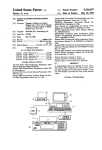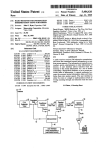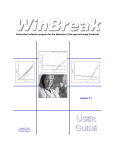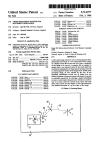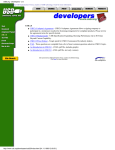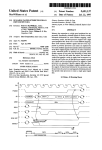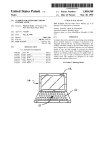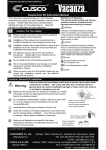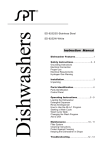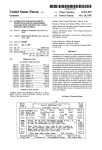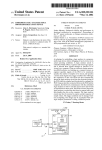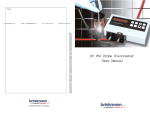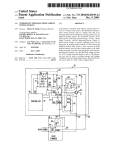Download OVERSHOOT
Transcript
USO05757356A United States Patent [19] [11] Patent Number: Takasaki et al. [45] Date of Patent: [54] INPUT DATA DISPLAY DEVICE [75] Inventors : Yukio Takasaki. Kyoto: Takashi Imamura. Kyoto-fu. both of Japan [73] Assignee: Omron Corporation. Kyoto. Japan [21] Appl. No.: 654,016 May 28, 1996 [22] Filed: Related US. Application Data [63] [3 01 Continuation of Ser. No. 386,173, Feb. 9. 1995, abandoned, which is a continuation of Ser. No. 40.989, Mar. 31. 1993, abandoned. [5 1] [52] [58] [JP] rm. 01.6 Japan .................................. .. 4-076875 . . . .. . . . . . .. G09G 5/36 U.S. c1. ................... .. 345/133; 345/145 Field Of Search ................................... .. 345/173. 174. 345/163. 157.156. 145. 146. 133. 134. 135. 139.140; 178/18. 19 References Cited [5 6] 5,757,356 May 26, 1993 252171 390164 H1988 10/1990 European Pat. O?. . European Pat. OE. . 0164405 12/1991 Japan ................................... .. 364/188 OTHER PUBLICATIONS “User Manual”. 1992. pp. 118 to 125. IBM. “Method for converting charts in interactive display system”. C.C. Himelstein. Feb. 1985. pp. 5060—5061. IBM Techiniccal Disclosure Bulletin. v01. 33. No. 6A. Nov. 1990. pp. 291-293. IBM Technical Disclosure Bulletin. vol. 33. No. 7. Dec. 1990. pp. 120-122. Patent Abstracts of Japan. vol. 6. No. 100. (P-l21) JP-A-57 031 031. Feb. 1982. Primary Examiner—Xiao Wu Attorney, Agent, or Firm—Dickstein Shapiro Morin & Foreign Application Priority Data Mar. 31. 1992 ‘ U.S. PATENT DOCUMENTS Oshinsky LLP ABSTRACT [57] An input data display device makes it easier to input properly correlated relative corrections for a number of parameters. Relative amounts by which each of a number of parameters is to be adjusted can be displayed on the screen in a manner which shows their ranges and possible corre lation. The data are input when the operator touches spots which he selects on the display screen. The pressure of his ?nger causes data to be generated which represent those 5,005,116 5,093,796 4/1991 Fujital ................................... .. 364/188 input positions. A calculation device calculates output-ready 3/1992 Takada . relative correction values for the various parameters based 5,122,957 6/1992 Hattori . 5,239,458 8/1993 Suzuki ................. ...... .. 364/188 364/424.02 ...... .. 364/188 on these input position data. These values are transmitted to the connected device. FOREIGN PATENT DOCUNIENTS 043201 1/1982 2 Claims, 4 Drawing Sheets European Pat. Off. . OVERSHOOT Pa a A G RESPONSE a“, B Pbc HUNTING U.S. Patent May 26, 1998 F _ — _ _ — _ _ — Sheet 1 0f 4 _ _ “ _ _ _ _ w 5,757,356 _ _ _ '——"l I I I OPERATING l MEMORY V/ I I I I I INPUT UNIT 2 /‘f\ ' 3 5 Il /_T 4 : CPU I — I CRT I ---—-—— ,1 L/ I I l ‘ I I TRANSMISSION I I UNIT ~—r/ I I L I _ _ _ _ _ _ _ _ _ _ _ 1I»~ _ _ _ _ ..____ _ _ _ __...| ___ TEMPERATURE "L CONTROLLER f’ 10"‘ r “"1 5!‘ FURNACE JR 6 US. Patent May 26, 1998 ( START Sheet 2 0f 4 5,757,356 ) INITTAL DISPLAY 5‘ S2 , INPUT NO DATA FIG. 2 DISPLAY TNPUT POSITION S3 CALCULATION OF OUTPUT-READY RELATNE CORRECTIONS 84 S5 $6 S7 DISPLAY RELATIVE CORRECTION VALUES TRANSMIT DATA '? No TRANSMTT NO 58 YES US. Patent May 26, 1998 Sheet 3 0f 4 OVERSHOOT RESPONSE B Pb C HUNTING FIG. 3 OVERSHOOT A RESPONSE B pb A C HUNTING FIG. 4 5,757,356 US. Patent May 26, 1998 Sheet 4 of 4 AV FIG. 5 START 21 R.l mMmEHEM\\mmEm 0 V SE .R5nHlSuRRE MDDNIFNN 7i|, WL EGgWlS S$ % m L M F 5,757,356 5.757.356 2 1 It is another object of this invention to display the relative INPUT DATA DISPLAY DEVICE correction values on the display screen. continuation application of Ser. No. 08/040989. ?led Mar. It is another object of this invention to provide a display of the graph of each of the control parameters on the display screen so that the operator can con?rm by graph how the 31. 1993. now abandoned. corrections on the controlled device are done. This application is a continuation of application Ser. No. 8886.173. ?led Feb. 9. 1995. now abandoned. which is a Brie?y described those and other objects are accom FIELD OF THE INVENTION plished in accordance with its apparatus aspects by provid This invention concerns an input data display device which can be connected to various types of control devices. ing an input data display device with a screen on which relative amounts by which each of a number of parameters is to be adjusted. The parameters can be displayed in a manner which shows their ranges and possible correlations. The invention further includes a means to input relative It allows an operator to input data more visually so that an interactive input operation is possible. BACKGROUND OF THE INVENTION Furnaces and other heating devices use temperature corrections. When input occurs in a position on the screen which the user selects. the device generates data represent ing that position. A means to compute relative corrections is adjusters (control devices) to control the heat sources so as to maintain heat at a given temperature. The control param also provided such that when the input display device receives the data representing input position. it uses those data to compute and output relative corrections for each of eters for this type of temperature control include overshoot. response and hunting parameters. When the temperature control is faulty. it will be necessary to make relative adjustments in the control parameters corresponding to the 20 the parameters. The device also has a means to transmit the aforesaid relative corrections to equipment connected to the existing quality of temperature control. If. for example. a input data display device. proportional-integral-derivative (PID) control circuit is normal. In the past. when the relative values of each of the With these and other objects; advantages and features of the invention that may become hereinafter apparent. the nature of the invention may be further understood by refer ence to the following detailed description of the invention. the appended claims and to the several drawings attached herein. aforesaid parameters needed to be changed. the corrected values were actually input via a keyboard. However. chang ing the relative values entails taking into account the cor FIG. 1 is a block diagram showing the structure of the being used to control temperature. changing the relative values of each parameter and properly adjusting the PID gains will return the quality of the temperature control to relation of the corrected values with various other param eters. It is dif?cult and extremely time-consuming to determine. in a correlative fashion. the relative correction to be applied to each parameter. 25 BRIEF DESCRIPTION OF THE DRAWINGS invention; FIG. 2 is a ?owchart of the operations which occur during 35 FIG. 3 is an example of a display screen during the input steps of FIG. 2; For example. if the operator knew that the state of the temperature control involved no hunting. a large overshoot. and a response which is slightly faulty. then he would FIG. 4 is an example of another screen display during the input steps of FIG. 2; FIG. 5 is an example of a graphic display produced according to this invention; and modify the relative values so as to make a large correction in the overshoot and a small correction in the response. However. the corrected values for overshoot and response must be determined in a correlative fashion. Determining a relative correction of the value for each parameter requires a great deal of skill acquired through experience. SUMMARY AND OBJECTS OF THE INVENTION In view of the di?iculty of correlating corrections to parameter behavior. as evidenced by the above example. this invention provides. as its primary object. an input data display device which enables an operator to input values for the relative correction of a number of parameters which are properly correlated. When this invention is used. correlated FIG. 6 is a flow chart of the operations for producing the graphic display of FIG. 5. 45 DETAILED DESCRIPTION OF THE INVENTION Referring to the drawings. wherein like reference num bers refer to like elements. FIG. 1 illustrates a block diagram 50 corrections for a number of parameters are input via a 55 display screen. Data representing these input positions are used to compute output values for relative corrections for each parameter. The values which have been computed are then transmitted to equipment connected to the input data input; showing the con?guration of this invention. Speci?cally. it illustrates an input data display device 1 which includes an input unit 2 for entering the relative corrections for input parameters; a display 3. a central processor 4 which pref erably consists of a microcomputer (although any suitable processor may be employed); a memory 5. in which the operating program for the CPU 4 and other various data are stored; a transmission unit 6. which acts to transmit the data; and an operating unit 9. In the illustrated embodiment. the input device 1 is connected to a temperature controller 11. in display device. order to control the temperature of the furnace 10. However. It is another object of the invention to provide an input data display device that is equipped with a means to display each of the aforesaid relative correction values which are to it is contemplated that the input device 1 can be employed to control any suitable device. The input unit 2 can be of any construction. A preferable construction however involves a transparent laminated resis 65 tive sheet for the X/Y coordinates and a ?lm electrode sheet under the resistive sheet. Such construction effectively cre data display device having a means to display a control ates a digitizer. Such a digitizer would produce a signal status graphically over time on a display. be output. It is yet another object of the invention to provide an input 5,757,356 3 4 encoding the coordinates of the position when the pressure one black triangle on the response axis B to represent the produced by. for example. an operator‘s ?nger touching that relative correction values (Step 5). point. is detected. The cathode ray tube (CHI) 3 is the When the operator views the display. if he believes that the above degree of correction values. are the appropriate preferred display device although any conventionally known display can be used The aforesaid input unit 2 is installed on top of the CRT 3 to form a single unit. This combined unit. with its screen capable of receiving input as well as for display. constitutes the device to input the relative correc ones to rectify the current state of control. he uses the operating unit 9 to initiate a “transmit data” command (Step 6). This command causes the relative correction value corresponding to the display to be sent to the data transmis sion unit (Step 7). The correction values are then transmitted to temperature controller 11. If the operator on viewing the tions. The CPU 4 serves as the device which computes the relative values for correction. The CPU 4 receives the input position data from input unit 2 and computes from these data the relative corrected values to output for each parameter. In addition. it controls display on the CR1‘ 3 of the relative display feels that the values are not correct. he uses the operating unit 9 to initiate a “reset” command (Step 8). This will cause the CRT screen to resume its initial display. and corrections of each parameter in a manner which shows how those corrections are correlated. Finally. the CPU 4 sends output values to the transmission unit 6 and then causes these values to be transmitted from unit 6 to the temperature controller 11. With reference to the ?owchart in FIG. 2 the operations of input device 1 are shown and the current state displays of the device are shown in FIGS. 3 and 4. In the exempli?ed application. the current state of control of the temperature of furnace 10. as mediated by temperature controller 11. is as follows: (at) There is no hunting; (b) there is a considerable overshoot; and (c) the response is slightly defective. As a result. the operator must make (a) a large correction in the overshoot and (b) a small correction in the response. No correction in hunting is necessary. Before any correction data are input. the initial display (shown in FIG. 3) appears on the screen (Step 1). This display shows the distribution of correlated degrees of control applied to the various parameters. As shown in FIG. 3. in the center of the screen 30 is a slightly ?attened circle E with an origin G. Radiating from origin G are overshoot axis A. response axis B and hunting axis C. which roughly divide the circle into three segments. Origin G represents 20 he can then input di?erent relative corrections. As a consequence with input unit 2. pressing a single spot makes it possible for a number of properly correlated relative correction values to be output to the temperature controller 11. Furthermore. these values can be confirmed by CRT 3 before being output. These relative correction values. then. offer an effective way to rectify the state of control. In the embodiment discussed above. data were input via a digitizer overlaid on the screen of CRT 3. However. it would also be possible to use either a mouse. key input. or move a cursor to enter the correction data. 25 30 Furthermore. the input data display device 1 is usually separate from the devices to which it is connected. such as a temperature controller 11. However. the present invention can include an input data display device 1 which is built into the controlled equipment. Referring now to FIG. 5. the graph display operation performed by CRT 3 in the example discussed above. is shown. This display operation can be performed before the relative correction values discussed above have been output. 35 It is initiated by a “display graph" command input via the operating unit 9. The graph of FIG. 5 is based on temperature variation data associated with the state of control (for zero relative correction for each of the axes A. B and C. The example. control temperature. heating temperature and points where the axes meet the periphery of the circle E ambient temperature). which are received from the tempera represent maximum relative corrections. Input unit 2. which ture controller 11. as described with reference to FIG. 1. is mounted on the Speci?cally. FIG. 5 shows a graphic display with three sets of temperature data. (a). (b) and (c). which were received from the temperature controller 11. The dotted line surface of CRT 3. has ?xed coordinate positions which match those of circle E. origin G and axes A. B and C. L on the screen erases whatever vertical line (x coordinate n) is written in and writes in a new vertical line L on the line Using this input data display device. and the above control conditions. the user desires to make a large correction in the overshoot and a small correction in the response. The operator will then press point P on the surface of input unit 2 (Step 2). This point is in the area in circle E between overshoot axis A and response axis B. It is close to overshoot axis A (thus representing a small correction in the response axis B) and near the periphery of the circle E for that axis as well. The position to press is chosen intuitively to corre spond to the desired correction. Pressing the screen 3 causes the input unit 2 to generate a signal which represents the coordinates of the position that was pressed. When this signal is generated. the spot which was touched is displayed on CRT 3 (Step 3). Vector T. which has origin G as its starting point and the coordinate position as its endpoint. is analyzed into its vector components in order to calculate relative correction value Pa for overshoot and relative cor rection value P,b for response. These relative correction values are then further re?ned. and finally output-ready relative correction values are calculated as integer values from 1 through 5 (Step 4). In this example. the ?nal relative 45 50 where the old data are written. one line width to the right (x coordinate: n+1). The latest data received are written in where the vertical line was erased (x coordinate: n). FIG. 6 is a ?owchart illustrating the operations for gen erating the graph of FIG. 5. If the graph has a grid line V in the location where the vertical line was erased in Step 1. this grid line V is written in as Step 2. Line Y indicates the reference level. As the operation described in Steps 1 to 4 is performed repeatedly. vertical line L moves from left to right on the screen as time elapses. As line L moves. the old data 55 are replaced by the most recent data. This type of display allows the display of data graphically over time with mini mum rewriting. As explained. this invention has a graphic display which allows the operator to use his intuition to input correlated relative corrections for a number of parameters. This system makes it easy to obtain properly correlated relative correc tions for each of the parameters. It allows relative correction values to be determined in a correlative fashion without requiring a high degree of operator skill. Furthermore. correction value for the overshoot parameter is 30 “3.” and for the response parameter is “1.” Based on these output 65 displaying the relative values allows the displayed data to be veri?ed. thus enabling the operator to determine the relative values for relative correction. the CR1" 3 displays. as shown corrections more accurately. in FIG. 4. three black triangles M on overshoot axis A and 5,757,356 6 5 Although only a preferred embodiment is speci?cally means responsive to said selected location for adjusting illustrated and described herein. it will be appreciated that one or more of the output values for said parameters in modi?cations and variations of the present invention are accordance with the selected location; possible in light of the above teachings and within the purview of the appended claims without departing from the spirit and intended scope of the invention. means for outputting said plurality of adjusted output parameter values; and said display device displaying said plurability of adjusted What is claimed is: 1. An input data display device for entering parameter output parameter values respectively on said axes; control data for a controller. said input data display device comprising: a display device for displaying respective axes. each of which represents an associated output control parameter. said axes having a common origin at the center of a substantial circular shape and terminating at the perimeter of said substantially circular shape. said axes forming between them wedge shaped areas on said display device; said axes respectively representing interrelated control parameters for a controller. which parameters include overshoot. hunting and response; means for selecting a location on said display device to thereby input position data which position data. by virtue of its location on said display device and rela tionship to each of said axes. represents simultaneous corrections to be made in said interrelated control parameters; 10 wherein selection of a said location within one of said wedge shaped areas corrects control parameters asso ciated with the axes bordering said one wedge shaped area. 2. The input data display device of claim 1. further comprising: means to display a plurality of variation data corrected by said plurality of output parameters graphically over time; and transmission means for transmitting said plurality of output values to said controller. * * * * ‘F








